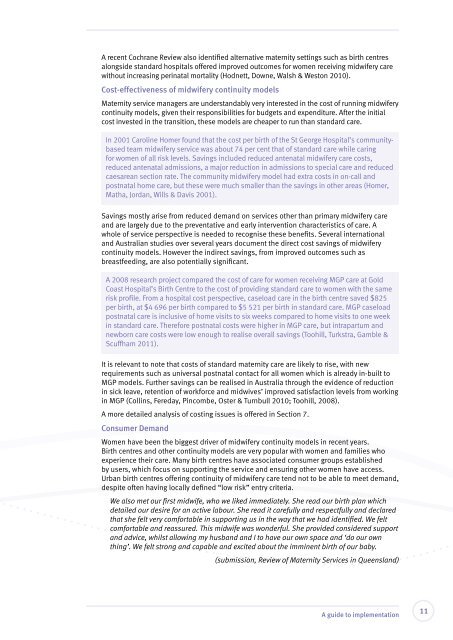Delivering continuity of midwifery care to Queensland women
Delivering continuity of midwifery care to Queensland women
Delivering continuity of midwifery care to Queensland women
Create successful ePaper yourself
Turn your PDF publications into a flip-book with our unique Google optimized e-Paper software.
A recent Cochrane Review also identified alternative maternity settings such as birth centres<br />
alongside standard hospitals <strong>of</strong>fered improved outcomes for <strong>women</strong> receiving <strong>midwifery</strong> <strong>care</strong><br />
without increasing perinatal mortality (Hodnett, Downe, Walsh & Wes<strong>to</strong>n 2010).<br />
Cost-effectiveness <strong>of</strong> <strong>midwifery</strong> <strong>continuity</strong> models<br />
Maternity service managers are understandably very interested in the cost <strong>of</strong> running <strong>midwifery</strong><br />
<strong>continuity</strong> models, given their responsibilities for budgets and expenditure. After the initial<br />
cost invested in the transition, these models are cheaper <strong>to</strong> run than standard <strong>care</strong>.<br />
In 2001 Caroline Homer found that the cost per birth <strong>of</strong> the St George Hospital’s communitybased<br />
team <strong>midwifery</strong> service was about 74 per cent that <strong>of</strong> standard <strong>care</strong> while caring<br />
for <strong>women</strong> <strong>of</strong> all risk levels. Savings included reduced antenatal <strong>midwifery</strong> <strong>care</strong> costs,<br />
reduced antenatal admissions, a major reduction in admissions <strong>to</strong> special <strong>care</strong> and reduced<br />
caesarean section rate. The community <strong>midwifery</strong> model had extra costs in on-call and<br />
postnatal home <strong>care</strong>, but these were much smaller than the savings in other areas (Homer,<br />
Matha, Jordan, Wills & Davis 2001).<br />
Savings mostly arise from reduced demand on services other than primary <strong>midwifery</strong> <strong>care</strong><br />
and are largely due <strong>to</strong> the preventative and early intervention characteristics <strong>of</strong> <strong>care</strong>. A<br />
whole <strong>of</strong> service perspective is needed <strong>to</strong> recognise these benefits. Several international<br />
and Australian studies over several years document the direct cost savings <strong>of</strong> <strong>midwifery</strong><br />
<strong>continuity</strong> models. However the indirect savings, from improved outcomes such as<br />
breastfeeding, are also potentially significant.<br />
A 2008 research project compared the cost <strong>of</strong> <strong>care</strong> for <strong>women</strong> receiving MGP <strong>care</strong> at Gold<br />
Coast Hospital’s Birth Centre <strong>to</strong> the cost <strong>of</strong> providing standard <strong>care</strong> <strong>to</strong> <strong>women</strong> with the same<br />
risk pr<strong>of</strong>ile. From a hospital cost perspective, caseload <strong>care</strong> in the birth centre saved $825<br />
per birth, at $4 696 per birth compared <strong>to</strong> $5 521 per birth in standard <strong>care</strong>. MGP caseload<br />
postnatal <strong>care</strong> is inclusive <strong>of</strong> home visits <strong>to</strong> six weeks compared <strong>to</strong> home visits <strong>to</strong> one week<br />
in standard <strong>care</strong>. Therefore postnatal costs were higher in MGP <strong>care</strong>, but intrapartum and<br />
newborn <strong>care</strong> costs were low enough <strong>to</strong> realise overall savings (Toohill, Turkstra, Gamble &<br />
Scuffham 2011).<br />
It is relevant <strong>to</strong> note that costs <strong>of</strong> standard maternity <strong>care</strong> are likely <strong>to</strong> rise, with new<br />
requirements such as universal postnatal contact for all <strong>women</strong> which is already in-built <strong>to</strong><br />
MGP models. Further savings can be realised in Australia through the evidence <strong>of</strong> reduction<br />
in sick leave, retention <strong>of</strong> workforce and midwives’ improved satisfaction levels from working<br />
in MGP (Collins, Fereday, Pincombe, Oster & Turnbull 2010; Toohill, 2008).<br />
A more detailed analysis <strong>of</strong> costing issues is <strong>of</strong>fered in Section 7.<br />
Consumer Demand<br />
Women have been the biggest driver <strong>of</strong> <strong>midwifery</strong> <strong>continuity</strong> models in recent years.<br />
Birth centres and other <strong>continuity</strong> models are very popular with <strong>women</strong> and families who<br />
experience their <strong>care</strong>. Many birth centres have associated consumer groups established<br />
by users, which focus on supporting the service and ensuring other <strong>women</strong> have access.<br />
Urban birth centres <strong>of</strong>fering <strong>continuity</strong> <strong>of</strong> <strong>midwifery</strong> <strong>care</strong> tend not <strong>to</strong> be able <strong>to</strong> meet demand,<br />
despite <strong>of</strong>ten having locally defined “low risk” entry criteria.<br />
We also met our first midwife, who we liked immediately. She read our birth plan which<br />
detailed our desire for an active labour. She read it <strong>care</strong>fully and respectfully and declared<br />
that she felt very comfortable in supporting us in the way that we had identified. We felt<br />
comfortable and reassured. This midwife was wonderful. She provided considered support<br />
and advice, whilst allowing my husband and I <strong>to</strong> have our own space and ‘do our own<br />
thing’. We felt strong and capable and excited about the imminent birth <strong>of</strong> our baby.<br />
(submission, Review <strong>of</strong> Maternity Services in <strong>Queensland</strong>)<br />
A guide <strong>to</strong> implementation<br />
11
















